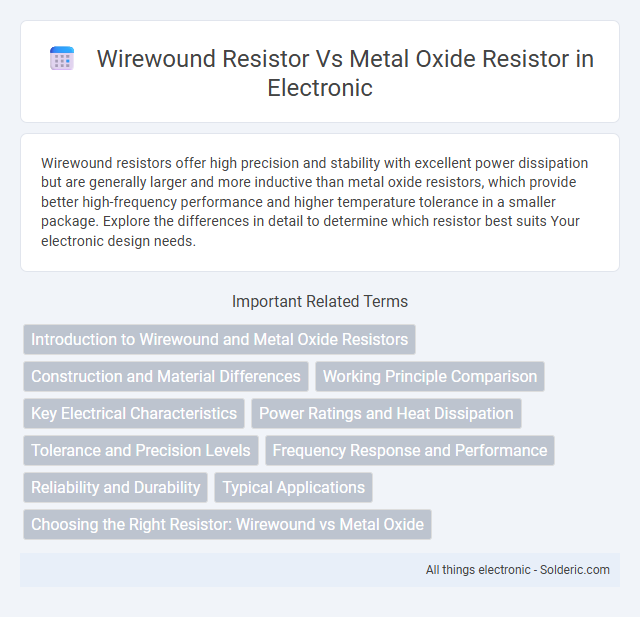Wirewound resistors offer high precision and stability with excellent power dissipation but are generally larger and more inductive than metal oxide resistors, which provide better high-frequency performance and higher temperature tolerance in a smaller package. Explore the differences in detail to determine which resistor best suits Your electronic design needs.
Comparison Table
| Feature | Wirewound Resistor | Metal Oxide Resistor |
|---|---|---|
| Construction | Resistive wire wound on ceramic core | Metal oxide film deposited on ceramic substrate |
| Resistance Range | Low to very high (0.1 O to over 1 MO) | Medium to high (1 O to 10 MO) |
| Power Rating | High power (up to 50W or more) | Moderate power (typically up to 5W) |
| Tolerance | +-0.1% to +-5% | +-1% to +-5% |
| Temperature Coefficient | Low (+-5 to +-50 ppm/degC) | Moderate (+-100 to +-300 ppm/degC) |
| Noise | Very low noise | Moderate noise |
| Inductance | High inductance due to coil structure | Low inductance (non-inductive design) |
| Applications | High power circuits, precision applications | General purpose, high temperature environments |
| Cost | Higher cost | Lower cost |
Introduction to Wirewound and Metal Oxide Resistors
Wirewound resistors use a metal wire, typically nichrome, wrapped around an insulating core, providing high precision and power dissipation ideal for high-current applications. Metal oxide resistors consist of metal oxide film deposited on a ceramic rod, offering excellent stability, moisture resistance, and higher temperature tolerance compared to carbon film resistors. Your choice between wirewound and metal oxide resistors depends on the required power rating, accuracy, and environmental conditions of your electronic circuit.
Construction and Material Differences
Wirewound resistors consist of a metal wire, typically nichrome, wound around an insulating ceramic core, providing precise resistance and excellent heat dissipation. Metal oxide resistors are made by depositing a metal oxide film on a ceramic substrate, offering high-temperature stability and better tolerance to voltage surges. Your choice depends on whether you prioritize mechanical robustness and accuracy (wirewound) or thermal stability and surge protection (metal oxide).
Working Principle Comparison
Wirewound resistors operate by using a metal wire, typically made from nichrome, coiled around a ceramic, fiberglass, or plastic core, converting electrical energy into heat through resistive heating. Metal oxide resistors consist of a ceramic core coated with a metal oxide film, providing resistance by controlling electron flow across the oxide layer. Wirewound resistors generally offer higher precision and power handling due to their construction, while metal oxide resistors provide better voltage surge tolerance and stability in varying environmental conditions.
Key Electrical Characteristics
Wirewound resistors offer high precision and stability with low noise and excellent power dissipation, making them ideal for high-current applications. Metal oxide resistors provide better temperature stability and higher surge tolerance, often exhibiting lower inductance compared to wirewound types. Both resistor types differ significantly in tolerance, thermal resistance, and frequency response, impacting their suitability in specific electronic circuits.
Power Ratings and Heat Dissipation
Wirewound resistors typically offer higher power ratings, often exceeding 5 watts, due to their robust construction using a metal wire coil which provides excellent heat dissipation. Metal oxide resistors, while generally limited to power ratings around 1 to 3 watts, feature a ceramic oxide film that enables better thermal stability and faster heat dissipation under moderate loads. Both resistor types effectively manage heat, but wirewound resistors are preferred in high-power applications requiring durability and consistent performance.
Tolerance and Precision Levels
Wirewound resistors typically offer tighter tolerance levels, often as precise as +-0.1%, making them ideal for high-accuracy applications. Metal oxide resistors generally have wider tolerances, commonly around +-1% to +-5%, which suits less critical circuits where high precision is not essential. Your choice between these resistor types should balance the required precision and tolerance against factors like cost and environmental stability.
Frequency Response and Performance
Wirewound resistors exhibit excellent frequency response and stability, making them ideal for high-precision applications requiring low noise and minimal inductance at low frequencies. Metal oxide resistors perform well under high temperatures and offer better stability at higher frequencies due to their non-inductive construction, ensuring consistent performance in RF and pulse applications. Your choice between these resistors depends on the specific frequency range and environmental conditions of your electronic system.
Reliability and Durability
Wirewound resistors exhibit exceptional reliability and durability due to their robust construction with a metal wire wound around an insulating core, offering high tolerance to temperature variations and power surges. Metal oxide resistors provide excellent stability and resistance to oxidation, which enhances their lifespan in high-temperature and corrosive environments. When comparing the two, wirewound resistors are preferred for applications requiring high precision and power handling, while metal oxide resistors excel in environments demanding strong oxidation resistance and thermal stability.
Typical Applications
Wirewound resistors are commonly used in high-power applications such as power supplies, motor controls, and load testing due to their precision and ability to handle high temperatures. Metal oxide resistors excel in environments requiring high surge energy dissipation and stability, typically found in industrial equipment, automotive electronics, and high-frequency circuits. Both types provide reliable performance but are selected based on specific application demands involving power rating and thermal characteristics.
Choosing the Right Resistor: Wirewound vs Metal Oxide
Wirewound resistors offer high precision, stability, and power handling, making them ideal for applications requiring low noise and high surge tolerance. Metal oxide resistors provide excellent heat dissipation, corrosion resistance, and suitable performance in high-temperature environments, often at a lower cost. Choosing the right resistor depends on your circuit's power requirements, accuracy needs, and operating conditions to ensure optimal performance and longevity.
Wirewound resistor vs metal oxide resistor Infographic

 solderic.com
solderic.com